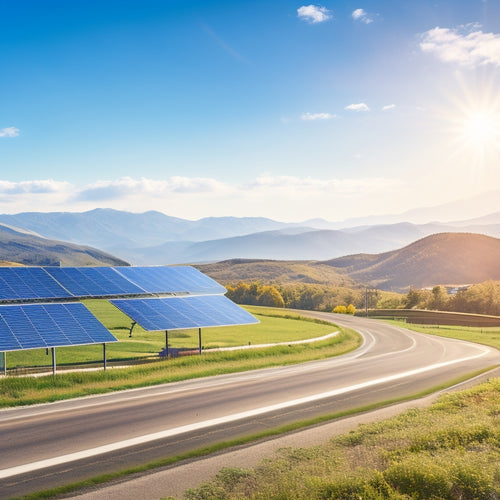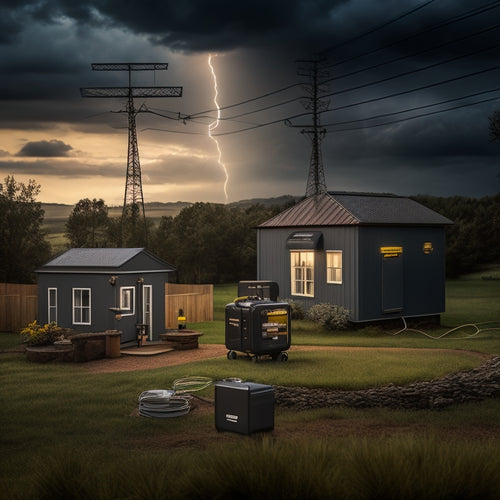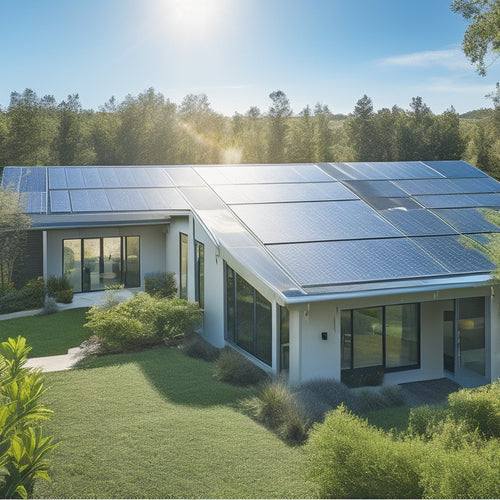
A Beginner's Guide to Renewable Energy System Design and Installation
Share
You'll start designing and installing a renewable energy system by evaluating your current energy usage and identifying areas for improvement. Examine your carbon footprint and existing infrastructure to determine the best sustainable technologies for your needs, such as solar panels or wind turbines. Consider energy storage solutions and local incentives to create an efficient system. Next, you'll explore your location's potential for renewable energy sources, assess your appliance efficiency, and calculate your daily energy consumption in watt-hours or kilowatt-hours. Understanding these factors will help you make informed decisions for ideal system design and performance in your renewable energy adventure.
At a Glance
- Identify energy sources suitable for your location, such as solar, wind, hydro, or geothermal power.
- Conduct an energy audit to understand energy usage patterns and pinpoint areas for improvement.
- Choose efficient solar panels and inverters to minimize energy losses and maximize energy production.
- Consider energy storage solutions, like batteries, to ensure a stable energy supply.
- Design a renewable energy system tailored to your specific energy needs and goals.
Reducing Carbon Footprint Matters
To shift towards a carbon neutral future, you must consider implementing eco-friendly practices in your renewable energy system design and installation. This involves evaluating your current energy consumption patterns, identifying areas of inefficiency, and developing strategies to offset your carbon footprint.
By integrating sustainable technologies, such as solar panels, which can generate clean energy and reduce reliance on the grid, you can greatly lower your energy bills and minimize your environmental impact.
Additionally, renewable energy sources produce little to no greenhouse gas emissions, making them a vital component in reducing emission levels and combating climate change.
Carbon Neutral Future
Embracing a carbon neutral future involves focusing on reducing your carbon footprint, and it's more important now than ever.
As you shift to a carbon neutral lifestyle, you'll need to evaluate your current energy usage and identify areas for improvement. This includes assessing your energy consumption patterns, identifying energy-intensive activities, and determining the most effective ways to reduce your energy usage.
By leveraging sustainable technologies, such as solar panels, wind turbines, and energy-efficient appliances, you can greatly reduce your carbon footprint.
Climate action requires a proactive approach to reducing greenhouse gas emissions, and incorporating these technologies into your daily life is a key step.
When designing and installing a renewable energy system, it's critical to take into account your specific energy needs and goals.
Eco Friendly Practices
Your daily choices have a substantial impact on the environment, and adopting eco-friendly practices is vital to reducing your carbon footprint.
When designing and installing a renewable energy system, it's imperative to evaluate the materials and technologies used. Opt for sustainable materials, such as recycled or locally sourced products, to minimize waste and support environmentally responsible suppliers.
Incorporating green technology into your renewable energy system can considerably reduce your carbon footprint. Think about using energy-efficient appliances, LED lighting, and smart home devices that can be controlled remotely to minimize energy consumption.
When selecting components for your renewable energy system, choose products with high efficiency ratings and environmentally friendly certifications, such as Energy Star or LEED.
In addition to using sustainable materials and green technology, reflect on the installation process itself. Hire contractors who use eco-friendly practices, such as minimizing waste and using environmentally friendly cleaning products.
Lowering Energy Bills Fast
To lower your energy bills quickly, you'll first need to identify areas of inefficiency in your energy usage. Start by conducting an energy audit, which involves tracking your energy consumption patterns and pinpointing wasteful habits.
This process is vital in solar technology, as it helps determine the ideal system capacity for your energy needs. Additionally, high-efficiency panels can reduce your carbon footprint, but it's important to evaluate the potential negative impacts on battery life expectancy.
Energy Audit Steps
Conducting an extensive energy audit is vital for identifying areas where energy consumption can be reduced, ultimately lowering your energy bills. To achieve this, you'll need to gather the right energy audit tools. These typically include a clipboard, a calculator, and a digital camera to document your findings. A thermal imaging camera can also be useful for detecting heat loss in your home.
Next, create an energy audit checklist to help you stay organized and guarantee you don't miss any important areas. This checklist should include items like lighting, insulation, windows, doors, and HVAC systems. As you work through your checklist, take note of any energy-efficient opportunities, such as upgrading to LED bulbs or sealing air leaks.
When conducting your energy audit, be sure to inspect your home's exterior and interior. Check for gaps and cracks in the walls, floors, and ceilings, and look for signs of moisture or water damage.
Reducing Energy Consumption
| Energy-Efficient Solution | Benefits |
|---|---|
| LED Lighting | Uses up to 90% less energy than incandescent bulbs |
| Smart Home Technology | Automatically optimizes energy usage based on your daily routine |
| Energy Star Appliances | Meets energy efficiency standards set by the U.S. EPA |
Inverter Efficiency Explained
When designing a renewable energy system, you'll need to choose an inverter that efficiently converts DC power to AC power.
To compare different inverter types, such as string inverters, microinverters, and power optimizers, you'll need to evaluate their efficiency ratings. Key factors affecting inverter efficiency ratings include maximum power point tracking (MPPT) efficiency, DC-AC conversion efficiency, and operating temperature.
Look for inverters with high peak efficiency ratings (above 98%) High Efficiency Ratings and low temperature coefficients to maximize energy yield.
Evaluate inverter durability against harsh environmental conditions to guarantee ideal performance.
Inverter Types Compared
Most modern renewable energy systems rely on inverters to convert DC power from solar panels or wind turbines into AC power for household use or grid feed-in.
As you investigate your options, you'll come across various inverter types, each with its strengths and weaknesses. String inverters are the most common type, connecting multiple solar panels to a single inverter. Micro inverters, on the other hand, connect to individual panels, providing more flexibility and monitoring capabilities.
Hybrid inverters combine the functions of a string inverter and a battery inverter, allowing for both grid-tied and off-grid operation. Power optimizers are DC-DC converters that optimize energy output from individual panels, often used in conjunction with string inverters.
Central inverters are typically used in large-scale solar installations, while battery inverters are designed for off-grid systems with energy storage. Grid-tied inverters are designed for systems that feed excess energy back into the grid.
As you choose an inverter, consider factors like system size, energy storage needs, and monitoring requirements to select the most suitable type for your renewable energy system.
Efficiency Rating Factors
Critical to inverter performance, efficiency ratings measure how effectively the device converts DC power into AC power. When selecting an inverter, you'll want to understand the efficiency metrics that impact its performance.
The most important metric is the maximum power point tracking (MPPT) efficiency, which measures the inverter's ability to optimize energy production from your solar panels.
Another key efficiency rating is the weighted efficiency, also known as the European efficiency. This metric takes into account the inverter's performance at various power levels, providing a more accurate representation of its real-world efficiency.
You'll also want to evaluate the inverter's operating temperature range and how it affects efficiency.
To achieve performance optimization, look for inverters with high efficiency ratings across a wide range of operating conditions. A high-efficiency inverter will minimize energy losses, ensuring you get the most out of your renewable energy system.
When evaluating inverters, compare their efficiency metrics and assess factors like ambient temperature and power output. By choosing an inverter with high efficiency ratings, you'll be able to maximize your energy production and reduce your reliance on the grid.
Assessing Your Energy Usage
When evaluating your energy usage, you need to identify the sources of your energy consumption, including lighting, heating, cooling, and appliances.
To accurately calculate your daily energy consumption, you'll need to gather data on the wattage and usage patterns of each energy-using device in your home or business. By understanding where and how you're using energy, you can begin to determine the best renewable energy solution for your needs.
Evaluating your energy usage also involves considering the efficiency of your appliances and lighting, such as switching to Energy Efficient Upgrades like LED bulbs and low-flow fixtures, which can greatly reduce your overall energy consumption.
Additionally, evaluating your energy usage can help you determine the ideal solar panel system design for your needs.
Identifying Energy Sources
To evaluate your energy usage effectively, you'll need to identify the energy sources that meet your needs and consider the site's specific conditions. This involves examining your location's potential for various renewable energy sources, such as wind energy, solar thermal, hydropower potential, and geothermal power. If you're near a coastline, tidal energy might also be an option.
Next, consider biomass options, such as organic waste or agricultural byproducts, which can be converted into energy.
It's also crucial to analyze the site's existing infrastructure and local renewable incentives that might support your energy diversification goals. Think about energy storage solutions to guarantee a stable energy supply, especially if you're planning to go off-grid.
When evaluating these energy sources, consider factors like resource availability, technology costs, and environmental impact. Evaluating your site's potential for multiple energy sources can help you create a hybrid system that maximizes your energy independence.
Calculating Daily Consumption
Next, use a wattmeter or a smart plug to measure the power consumption of each appliance in watts (W).
Record the number of hours each appliance is used per day and multiply it by its power consumption in watts. This will give you the total energy consumption in watt-hours (Wh) or kilowatt-hours (kWh) per day.
Be sure to also account for any energy-intensive activities, such as cooking or laundry, and adjust your calculations accordingly.
Zero Emission Energy Source
You'll likely consider solar power generation as a primary zero-emission energy source for your renewable energy system.
Photovoltaic (PV) systems, which convert sunlight into electricity, offer a reliable and efficient way to generate energy.
Solar Power Generation
Utilizing the energy of the sun, solar power generation has become a cornerstone of modern renewable energy systems. As you design and install your renewable energy system, it's crucial to evaluate the various solar panel types available. You'll need to choose between monocrystalline, polycrystalline, and thin-film solar panels, each with its own advantages and disadvantages.
When selecting solar panels, assess factors like efficiency, durability, and cost. Monocrystalline panels offer high efficiency and long lifespan, but are more expensive. Polycrystalline panels, on the other hand, are more affordable and still provide decent efficiency. Thin-film panels are the most budget-friendly option, but have lower efficiency and shorter lifespan.
Photovoltaic (PV) technology is the backbone of solar power generation. PV cells convert sunlight into electrical energy through a process known as photovoltaic effect. The efficiency of PV cells has improved greatly over the years, making solar power a viable option for many households and businesses.
Frequently Asked Questions
Can I Install a Renewable Energy System Myself?
You can attempt a DIY installation, but carefully weigh the risks and consider safety precautions to avoid electrical shock, falls, and other hazards, as improper setup can lead to system malfunctions or injuries.
What Are the Rebates for Renewable Energy Systems?
You're not limited by a lack of financial resources; federal incentives and state programs can help. You can claim a 30% tax credit and investigate state-specific rebates, like net metering, to offset your renewable energy system costs.
How Long Do Renewable Energy System Warranties Last?
You'll typically find renewable energy system warranties lasting 20-25 years, sometimes longer, offering warranty coverage that matches the expected system longevity, giving you peace of mind and protection for your investment in a free, clean energy future.
Can I Finance a Renewable Energy System?
Don't let upfront costs scare you - you can finance a renewable energy system. You'll find various financing options available, and a thorough cost analysis will help you choose the best fit for your energy independence.
Are Renewable Energy Systems Hurricane-Resistant?
When designing your renewable energy system, consider storm preparedness and system durability to guarantee it withstands hurricanes. You'll achieve this by selecting sturdy components, secure mounting, and following local building codes for a resilient installation.
Explore More
Implementing a renewable energy system can make a significant impact. Did you know that in the US, solar energy alone has the potential to power over 400 million homes. By following the design and installation steps outlined, you can effectively reduce your carbon footprint and lower your energy bills. Evaluating your energy usage, choosing the right inverter, and selecting a suitable zero-emission energy source are key to a successful system.
Related Posts
-

Is Switching to Green Energy Solutions Easy
Switching to green energy solutions isn't just easy; it's also beneficial. You can greatly cut utility costs and enjo...
-

Key Components of a Reliable Emergency Power Supply System
A reliable emergency power supply system requires several key components. You need proven performance metrics to guar...
-

Installing Metal Solar Roofs for Maximum Energy Efficiency
Installing metal solar roofs can drastically enhance your home's energy efficiency and durability. These roofs withst...


